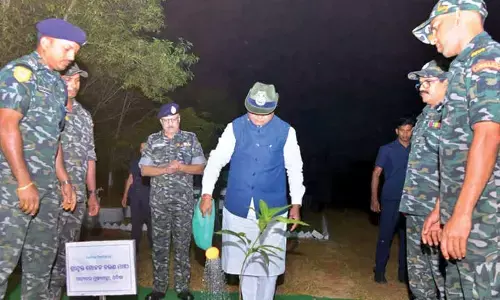Naga Hills rich in gold: Geologist

There\'s gold in them thar hills\" was a promotional campaign that ran in Georgia in the US for almost a century
.jpg) "There's gold in them thar hills" was a promotional campaign that ran in Georgia in the US for almost a century from the 1830s and this could well apply to the Naga Hills straddling India and Myanmar, which are a promising place to prospect for the yellow metal, according to a geologist who has worked extensively there.
"There's gold in them thar hills" was a promotional campaign that ran in Georgia in the US for almost a century from the 1830s and this could well apply to the Naga Hills straddling India and Myanmar, which are a promising place to prospect for the yellow metal, according to a geologist who has worked extensively there.
The discovery that can potentially put Nagaland on the gold map has been reported by Naresh Ghose, a retired geology professor of Patna University in the journal Current Science. His conclusion has emerged from an intensive study of rocks called "ophiolites" found in that region.
Ophiolites are slices of what were once the ocean floor but were thrust on to the continental crust more than 65 million years ago by the action of what geologists call plate tectonics, a mechanism that gave rise to the Himalayas.
The hill ranges of Nagaland and Manipur bordering Myanmar are one such place on earth where an ancient oceanic crust had emerged on the land as a result of collision of the Indian plate with the Eurasian plate.
The Naga Hills Ophiolite (NHO), as this region is called, consists of a variety of sedimentary rocks. Though the NHO was discovered in the 1970s its potential as a source of minerals was not realised till the 1980s when Ghose launched the study.
According to Ghose, the inaccessible nature of the terrain and lack of infrastructure are among the major constraints for undertaking a systematic study and exploitation of the NHO. Ghose says his preliminary study has brought to light the occurrence of gold in NHO in the native as well as in alloy form.
Ghose's study dealt with rocks exposed as ophiolite at the northern and eastern margin of India along the suture zone where India and Eurasia collided to form the Himalayan mountain range. About 1,200 thin sections of rocks collected from across the NHO by his students were analyzed using instruments at the Geological Survey of India (GSI) in Bangalore and were found to contain grains of both native gold and gold-silver alloy, the report said.
Gold mineralization in layered sections of Ophiolites "opens a new avenue for searching for primary gold in NHO," Ghose told IANS.
According to the report, gold in pure form and also as gold-silver alloy, is found to occur near Sutsu, a village in Phek district about 60 kilometres from Nagaland capital Kohima. Small, detached lenses or larger bodies of "gabbros" (igneous rocks) are encountered between Tizu River gorge and Lacham Lake in the central part of ophiolite belt. The largest body of ophiolite - three km in length, 2.5 km in width and 300 metres thick - is present east of Moki, the report said.
Ghose said that sediments in the northern and central parts of the ophiolite belt are favourable sites for exploration and prospecting of noble metals. Similarly, a search for placer deposits in the Tizu River and its tributaries flowing across the northern part of the ophiolite belt "is also favoured as an alternative prospect of secondary gold".
According to GSI, India now produces gold from Hutti, Uti and Hirabuddni mines in Karnataka and as by product from sulphide deposits of Khetri in Rajasthan and Mosabani, Singhbhum and Kundrekocha in Jharkhand. The Puga geothermal system is a "hot spring type" epithermal gold deposit in the making in the Ladakh region of Jammu and Kashmir.
Ghose said that the ophiolitic rocks of mantle and oceanic crust parentage at the continental plate margin in northeast India "have vast potential for intensive research and economic growth".
However, the extent of gold reserves in Nagaland cannot be predicted on the basis of his preliminary study. "It calls for a more detailed geophysical and geochemical studies," Ghosh added.
Next Story



















